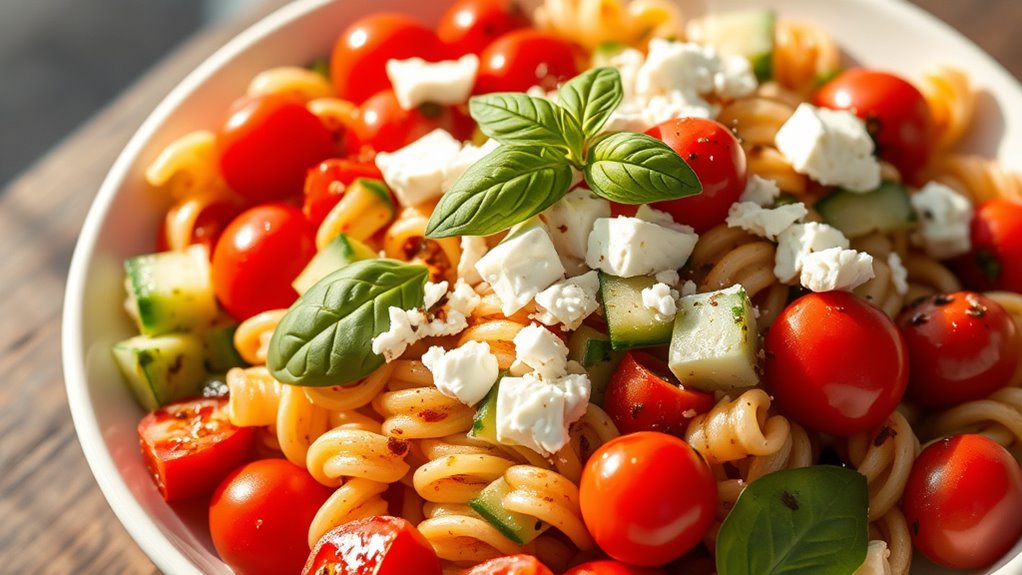This bright pasta salad comes together fast with a tangy balsamic vinaigrette that wakes up every bite. Cook your favorite short pasta to al dente, rinse to cool, and toss with crunchy veggies like peppers, cucumbers, and tomatoes. Whisk olive oil, balsamic, lemon juice, salt, and pepper for the dressing, then blend with pasta and optional feta or beans for extra heft. Chill briefly so flavors meld, and you’ll see textures pop—plus tips await if you keep going.
Ingredients and Quantity
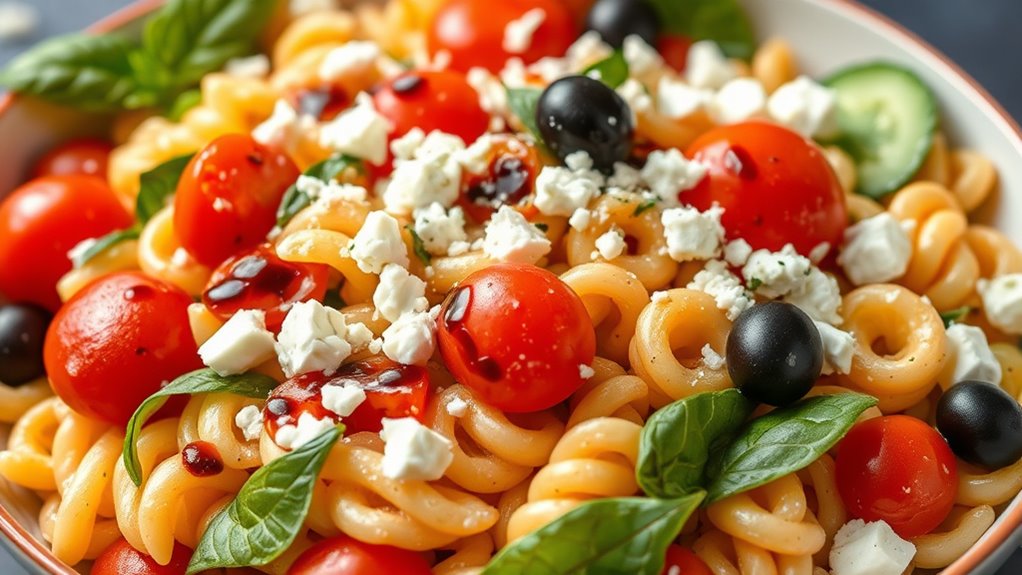
For a hearty pasta salad, gather about 12 ounces of short pasta, like rotini or penne, along with two cups of chopped vegetables such as bell peppers, cucumbers, and cherry tomatoes. You’ll balance textures and colors as you choose pasta varieties and dressing options, keeping the flavors bright and direct. Think al dente bites and crisp bits of veg, then pair with a simple, bold vinaigrette or a creamy alternative—your freedom, your taste. This section keeps it precise: measure, mix, taste, adjust.
| Item | Amount/Notes |
|---|---|
| Pasta varieties | 12 oz short pasta |
| Veggies | 2 cups chopped |
Preparations
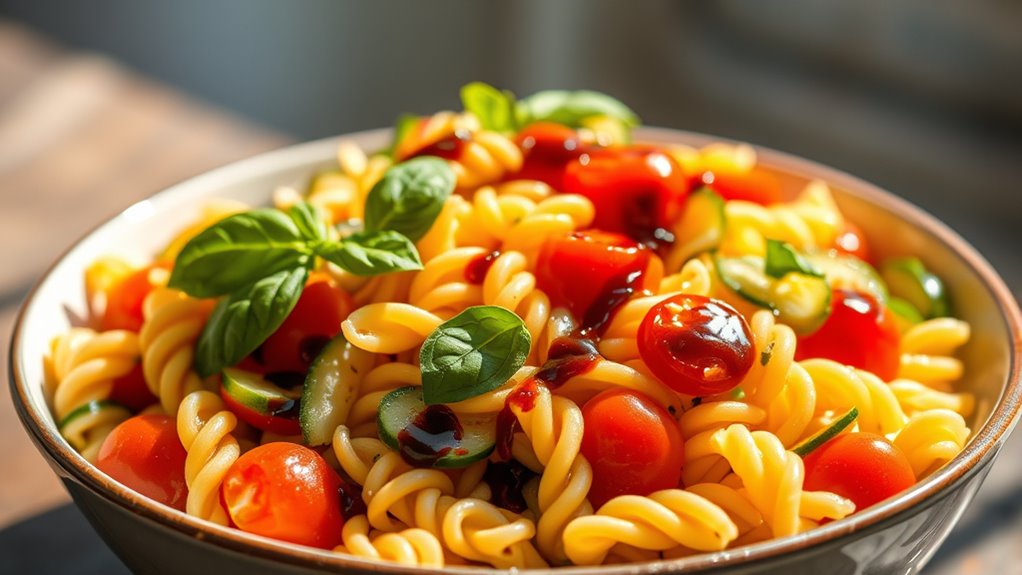
Now that you’ve picked the pasta and veggies, it’s time to assemble and prep everything for mixing. You’ll rinse lightly if needed, pat dry, and reserve cooled components so they stay bright. Focus on preparation techniques that keep textures distinct: bite from pasta, crispness from vegetables, and a glossy finish from the dressing. Toss components gently to avoid mush, then taste and adjust acidity or sweetness with small balsamic tweaks. If you need a faster route, consider ingredient substitutions like swapping feta for parmesan or using cherry tomatoes instead of garden varieties; these changes still deliver balance. Keep portions even, and prep sauce separately so you can fold it in just before serving. This approach preserves flavor, freedom, and cohesion.
Kitchen tools or Kitchenware Required
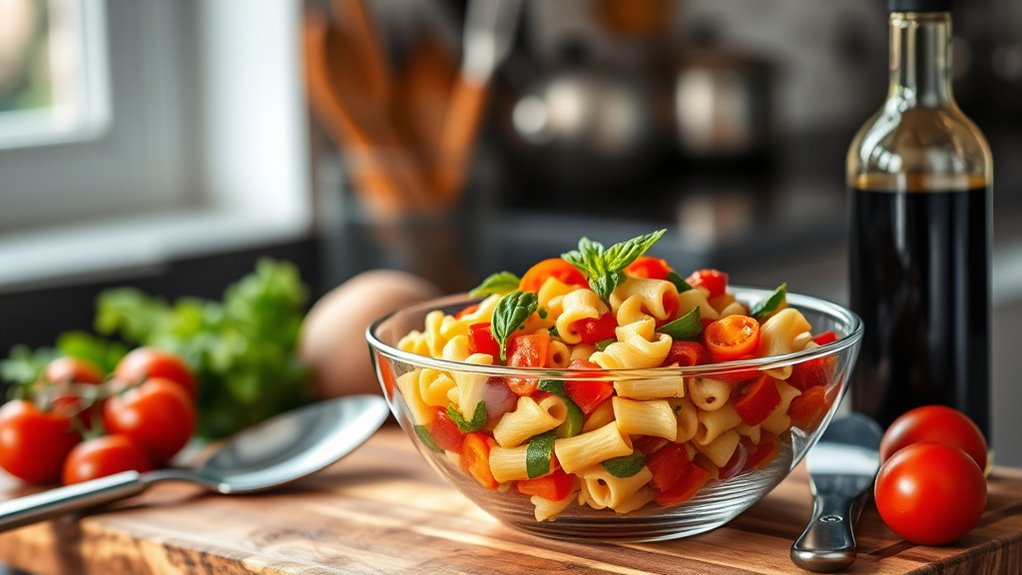
Gather the right tools and you’ll streamline prep and threading flavors together. You’ll want a few essentials that feel liberating to use. A sturdy cutting board and a smooth mixing bowl are your core companions, keeping prep steady and organized. Add a chef’s knife with a comfortable grip, a strainer for rinsing, and tongs for tossing. A microplane or zesting tool helps finish with brightness, while a measuring cup keeps balance precise. For storage, a sealable container guarantees leftovers taste bold later. Table below adds structure without clutter.
| Tool | Purpose |
|---|---|
| Cutting board | Safe, roomy chopping surface |
| Mixing bowl | Toss and blend ingredients evenly |
How to Cook
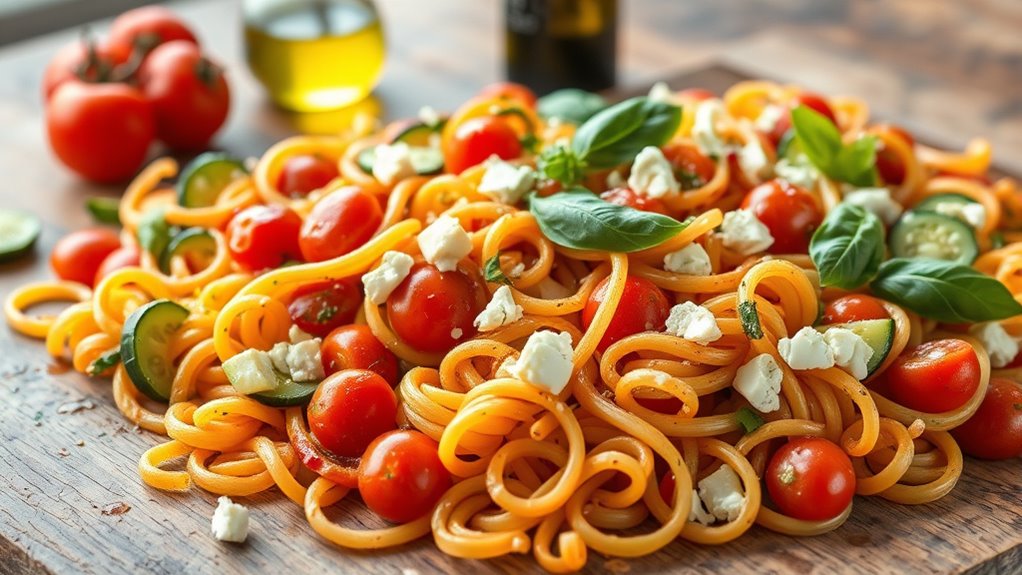
- Bring a pot of salted water to a rolling boil.
- Add pasta and cook until al dente.
- Drain the pasta, rinse lightly with cold water, and let it cool to prevent flavors from being overwhelmed by heat.
- In a bowl, whisk together balsamic vinegar, olive oil, salt, pepper, and a splash of lemon juice for brightness.
- Chop vegetables, herbs, and optionally feta or olives.
- Toss the cooled pasta with the dressing, chopped vegetables, herbs, and optional ingredients.
- Use gentle folding techniques to mix, avoiding crushing the pasta.
- Chill the salad briefly to allow flavors to meld.
- Balance flavor combinations by pairing sweet, sharp, and tangy notes with peppery greens and roasted peppers.
- Taste and adjust acidity and seasoning as needed.
- Aim for a vibrant, cohesive salad that travels well and encourages experimentation while maintaining balance.
How to Serve
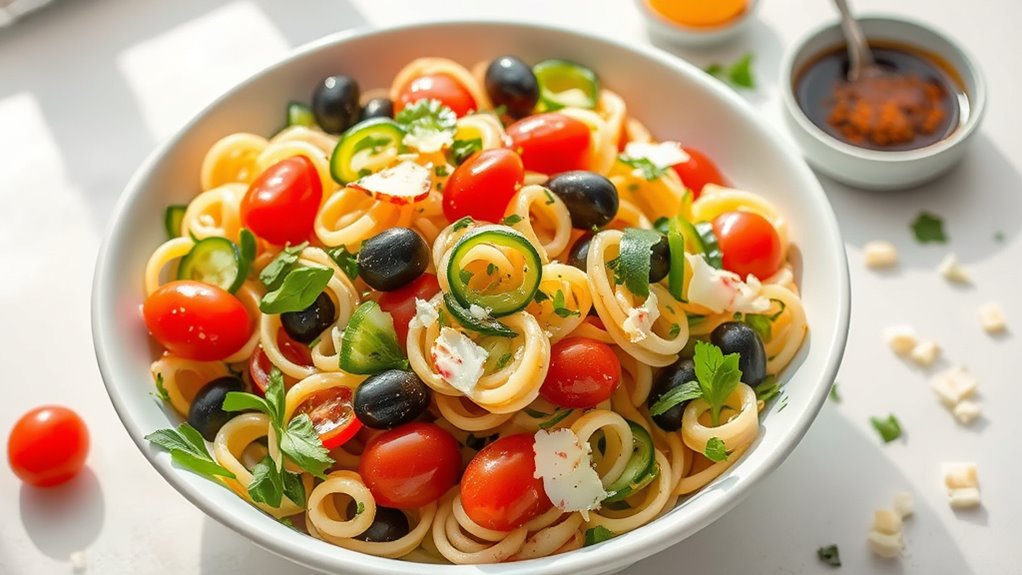
A pasta salad shines when plated at the right moment and in the right setting, so plan serving so it’s fresh and inviting. You’ll want to choose a shallow bowl or platter that shows off the colors and ingredients. Keep it chilled until your guests arrive, then lift the lid just before serving to release aroma. For serving suggestions, offer small bowls for tasting, a drizzle of balsamic vinaigrette on the side, and extra cheese or herbs for customization. Presentation ideas include arranging tomatoes, peppers, and olives like a mini mosaic, and placing cucumbers in crisp coils for visual contrast. Keep portions approachable and airy, letting the salad speak for itself through bright, balanced textures and vibrant texture.
Tips
Here are practical tips to keep your pasta salad bright and flavorful, no matter the crowd. Start with al dente pasta and a hot vinaigrette to help the dressing cling without becoming greasy. Dress lightly and adjust as it rests, so flavors mingle without sogginess. For dressing variations, keep a balance of tang, sweetness, and oil, then riff with herbs, citrus, or a pinch of chili for lift. Ingredient substitutions can include cherry tomatoes for bite, olives for brininess, or feta for creaminess; swap pesto for balsamic glaze if you crave richness. Chill briefly before serving to enhance tang and cohesion. Pack mix-ins separately if you’re ahead of time, then fold them in just before presenting. Taste and tailor to your crowd, freely.
Food Value and Benefit
Pasta salad provides a nutritious and balanced meal option that supports overall health and energy levels. Made with whole-grain noodles or light pasta, fresh vegetables, olive oil, herbs, and protein sources like cheese, beans, or lean meats, this dish offers a variety of essential nutrients.
Food Value:
- Whole-grain pasta supplies complex carbohydrates for sustained energy.
- Vegetables contribute dietary fiber, vitamins, and minerals.
- Olive oil adds healthy monounsaturated fats.
- Protein from cheese, beans, or lean meats supports muscle maintenance and satiety.
- Herbs and vinegar enhance flavor without adding excess calories.
Vitamins and Minerals:
- Vitamin A (from vegetables like carrots and leafy greens)
- Vitamin C (from tomatoes, peppers, and other fresh vegetables)
- B vitamins (from whole-grain pasta)
- Vitamin K (from leafy greens and herbs)
- Iron (from beans and lean meats)
- Magnesium (from whole grains and vegetables)
- Potassium (from vegetables)
- Calcium (from cheese)
Benefits of Eating This Recipe:
- Provides sustained energy without feeling heavy or sluggish.
- Supports healthy digestion due to high fiber content.
- Promotes muscle health and fullness through adequate protein.
- Contains antioxidants and anti-inflammatory compounds from olive oil and herbs.
- Encourages mindful eating with balanced portions.
- Offers essential vitamins and minerals that support immune function, bone health, and overall wellness.
- Versatile and easy to customize, fitting various dietary preferences and active lifestyles.
Frequently Asked Questions
Can I Make This Ahead Without the Pasta Getting Soggy?
Yes, you can prep ahead; keep pasta al dente, store with dressing separately, and add veggies just before serving. For best Pasta storage and Salad freshness, chill, seal tightly, and avoid soggy texture.
Which Pasta Shapes Work Best With Balsamic Dressing?
You’ll find small shapes like orzo and fusilli shine, while long ribbons may cling; pasta shapes matter, so choose those that hold dressing compatibility. Ironically, you think variety restricts you, but it liberates texture, flavor, and carefree dining.
How Long Can Leftovers Stay Fresh in the Fridge?
Leftovers stay fresh in the fridge for about 3 to 4 days. You’ll maximize safety with proper sealing and quick cooling. Leftover storage and refrigerator tips help you enjoy freedom from wasted meals.
Can I Substitute Olive Oil for Balsamic Vinegar?
Yes, you can substitute olive oil for balsamic vinegar, though the flavor shifts. Substitution benefits include richer mouthfeel and smoothness, while the flavor profile becomes muted and rounded. You’ll discover a freer, savory dressing with lighter acidity.
Is This Salad Suitable for Gluten-Free Diets?
Yes, this salad can be gluten-free if you use gluten-free pasta and verify all add-ins. You’ll enjoy it while respecting dietary restrictions, feeling free to customize with gluten free pasta and vibrant, simple flavors.
